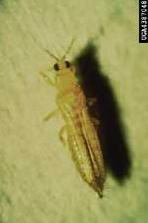 Do You Have Thrips? - May 14, 2008 Jeff Schalau, Associate Agent, Agriculture & Natural Resources, Arizona Cooperative Extension, Yavapai County It seems like every spring, thrips colonize a broad range of garden and landscape plants. At my house, they are most damaging to fruit trees. Rose growers are probably also very familiar with them. Thrips are very small insects and identification often requires a magnifying glass to see. Their damage often appears as scarred or distorted leaves, flowers and fruit. To complicate things, there are several species, some of which are predators that feed on mites and other small insects. Thrips are in the order Thysanoptera which means “fringed wing”. Adult thrips are slender, less than 1/20 inch long, have long fringes on the margins of both sets of their long, narrow wings, and are often yellowish or blackish and shiny. Immature thrips (nymphs) are similarly shaped with a long abdomen but lack fully developed wings and most species are translucent white to yellowish. When disturbed, many species of thrips will curve the tip of their abdomen upwards. Common pest thrips include the western flower thrips which feeds on vegetables, grapes, deciduous fruit trees, strawberries, raspberries and herbaceous plants; the onion thrips and the bean thrips feed on vegetables; the citrus thrips which feeds on citrus and pomegranate. All of these thrips look similar to the untrained eye and require close inspection (usually by an entomologist) to positively determine species. The best way to check for their presence is to hold an affected branch and tap it sharply against a clean, white sheet of paper. You don’t need to cut the branch off the plant. Look closely at the paper. If thrips are present, you will see tiny linear bodies that are moving around. Using magnification, you may see mostly wingless nymphs and possibly a few winged adults crawling around on the paper. By the way, the word "thrips" describes a single insect (i.e. there is no such thing as a “thrip”). Many species of thrips feed within buds and furled leaves or in other enclosed parts of the plant. This causes distorted leaves that may have blacken edges where the tissue has died. This is the most common symptom of thrips damage in our area. You may also notice stippled leaf surfaces. The stippled appearance looks similar to spider mite, plant bug or stink bug damage. Black specks (fecal materials) may also be visible. Look carefully for the insects themselves to be certain that thrips are present and the cause of damage before taking control action. By the time thrips damage is noticeable, natural enemies have probably already started controlling their populations. For this reason, pesticides should be applied only when serious damage is occurring. Heavy thrips infestations can harm fruit tree blossoms and reduce or eliminate the fruit crop. Most ornamental plants can tolerate thrips damage caused in spring and will develop normal leaves once the weather warms up in June. Supreme oil sprays and insecticidal soaps will control thrips and are the least toxic to non-target species, people, pets, and the environment. However, these products can harm plant tissue when temperatures are above 90 to 95 degrees F. Neem insecticides are also effective in controlling thrips. Neem is a botanically-derived pesticide that contains the active ingredient azadirachtin and is labeled for use on most edible crops. There are several conventional insecticides that are labeled for thrips, but read the label carefully because some of these may not be labeled for use on food crops. Personally, I’m getting tired of thrips damage. I have apple, pear and peach trees that really should have borne a fruit crop this year, but I’ve got no fruit. It is my suspicion that thrips damaged the blossoms so severely that the flowers never opened this year (the blossoms just withered and died). Next year, I plan on monitoring for thrips just prior to bloom. If they are present, I will likely treat them with a neem-based insecticide. The University of Arizona Cooperative Extension has publications and information on gardening and pest control. If you have other gardening questions, call the Master Gardener line in the Cottonwood office at 646-9113 ext. 14 or E-mail us at cottonwoodmg@yahoo.com and be sure to include your address and phone number. Find past Backyard Gardener columns or submit column ideas at the Backyard Gardener web site: http://cals.arizona.edu/yavapai/anr/hort/byg/. |